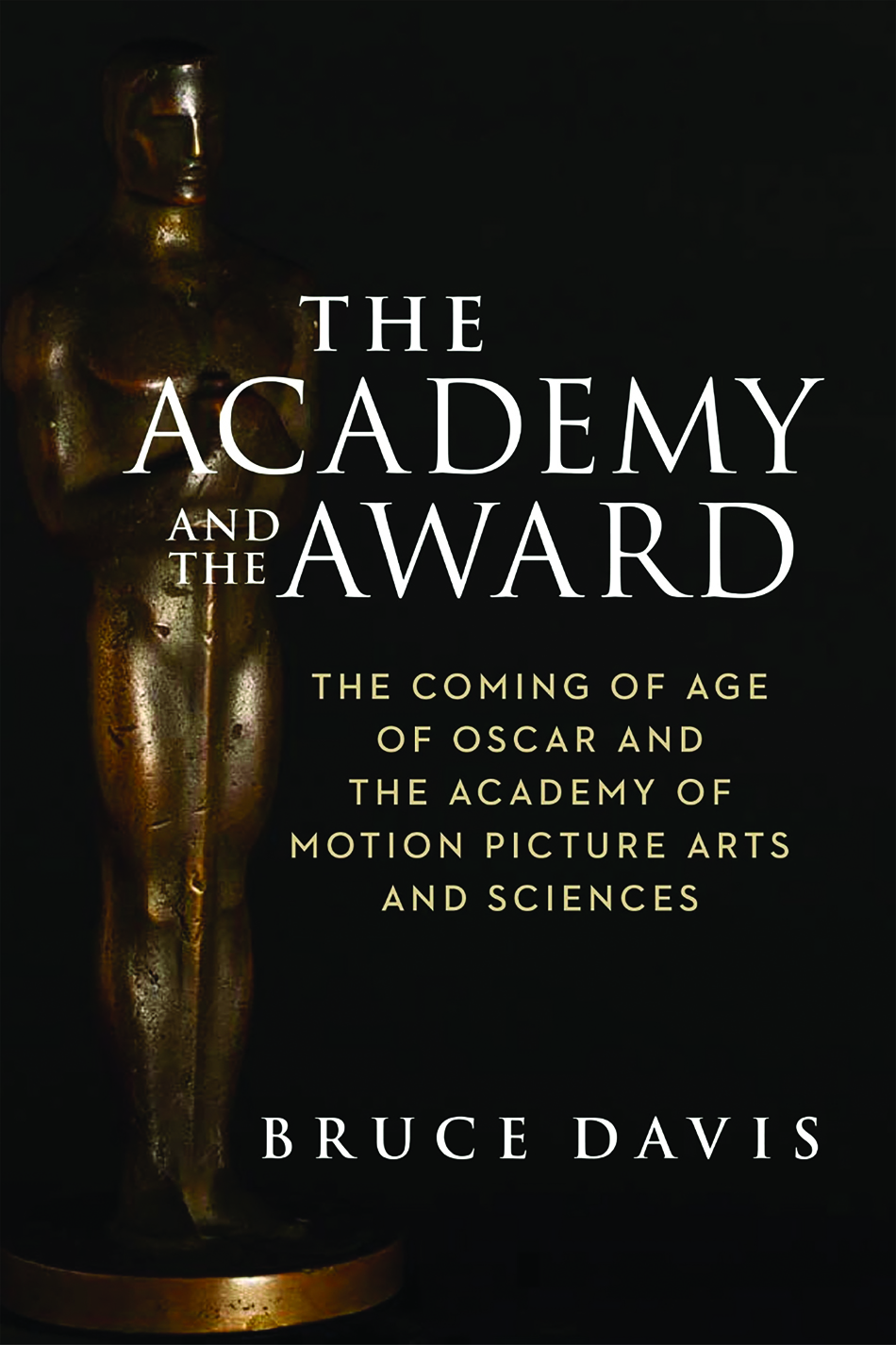The Oscars are one of our most powerful Hollywood rituals, yet the award and its presenting organization, the Academy of Motion Picture Arts and Sciences, are remarkably understudied. Bruce Davis’s The Academy and the Award fills a crucial gap, documenting the Academy’s first few decades as the organization and its premier emblem survived a rocky infancy and established the Oscar as an industrial and cultural phenomenon. “Oscar’s is an early life that deserves a bildungsroman,” Davis argues, and The Academy and the Award provides not just that biographical history but a corrective to a glaring absence in the field.1
Though film and media studies scholars have long used the Academy’s Margaret Herrick Library’s comprehensive collections, Davis admits that the Academy was historically reluctant to open its own institutional records. Davis was granted entry thanks in part to his long tenure as the former executive director of the Academy of Motion Picture Arts and Sciences, accessing a trove of correspondence, memos, and minutes from the Academy’s Board of Governors.2 Davis organizes the material into fifteen chapters, each constructed around a theme yet roughly chronological. The book spends more than half of its chapters on the Academy’s first decade, negotiating the Academy’s creation in 1927, its development of its signature award, its role in influencing technological standards and mediating labor disputes, and its prickly relationship with the Hays Office (whose funding of the Academy was a near-constant source of conflict). The book’s following chapters detail how a now-established Academy navigated through the end of the Great Depression, World War II, and the Cold War, documenting that while the Academy was theoretically freed from labor matters thanks to the industry’s unionization, it was continually impacted by both political ideologies and industrial allegiances. The book’s final three chapters detail the Academy’s consequential decision to publicly broadcast its annual ceremony, first on radio in 1930 and ultimately on television in 1953. The ceremony’s annual telecast would turn it into a global phenomenon, yet Davis concludes with a brief, rueful epilogue in which he wonders whether the Oscars will be able to regain their cultural impact in the rapidly changing media landscape.
Throughout the book, Davis supplements his thorough accounts of the Academy’s inner workings with biographical snapshots of people who were vital to its founding and operation. Many of the characters in Davis’s story are creative and historical powerhouses in their own right, including figures like Louis B. Mayer, Mary Pickford, Frank Capra, Bette Davis, and Gregory Peck. The prevalence of these figures emphasizes how profoundly the Academy was intertwined with the power structures of Hollywood. As Davis demonstrates, even at its most virtuously intentioned, the Academy was always an apparatus of the industry, vulnerable to its loyalties and biases; in one memorable anecdote, Davis recounts the decision to award studio chief Jack L. Warner a prestigious honorary award, sparking a nearly three-hour argument in the Academy’s boardroom.3 But Davis gives careful attention not only to well-known figures but also to those who had a tangible impact on the Academy’s history, chronicling the artists who sculpted the Oscar and the honorary Thalberg Award (a process complicated by Thalberg’s widow Norma Shearer, who was never quite satisfied with the tribute’s likeness). Most notably, Davis immortalizes the lives and contributions of Academy employees like Frank E. Woods, Donald Gledhill, Lester Cowan, and Margaret Herrick, creating a poignant tribute to the employees and officers who quietly shaped the Academy and, with it, film and television history. The book’s eighth chapter contains the story of Eleanore Lilleberg, an office assistant and secretary for the Academy. Lilleberg worked only fleetingly in the film industry, but Davis argues (convincingly if not, he admits, definitively) that she was the source of the “Oscar” moniker, restoring to the unknown Lilleberg her rightful due.
Davis puzzles over and unravels several of these long-held Academy myths. He debunks the legend that Bette Davis nicknamed the “Oscar” because the statuette’s derriere reminded her of her husband’s (or, less salaciously, that her brief AMPAS presidency was as dramatic as she later claimed) and also refutes the story that actor Emilio Fernandez posed for the statuette’s designer and served as its model. Those anecdotes are a fun detour into Hollywood gossip and a demonstration of Davis’s extensively detailed research. The Academy and the Award is particularly illuminating when it takes a broader view. The chapter on the Cold War is perhaps the book’s most intriguing, putting the Academy’s international film category into conversation with the thorny geopolitical climate before examining the Academy’s navigation of the House Un-American Activities Committee (HUAC) hearings and the industrial Blacklist. Davis does not shy away from the complicity of the Academy and some of its leaders, nor does he situate the era as a simple moral binary. Furthermore, the chapter is one of the few that skips ahead of its designated era to consider its long-term echoes and ramifications, examining the controversial presentation of an honorary Oscar to Elia Kazan in 1999.
Davis uses the Kazan episode to raise the Academy’s “Gauguin Problem”—in short, how to consider or honor art in relation to its deeply flawed artist.4 The issue is historically relevant and contemporarily urgent, both within the Academy and the cultural industries more broadly. A brief reference to the #MeToo movement (among other contemporary controversies) underscores that these intersections of gender, race, and power within the Academy are among the book’s under-examined themes, providing useful pathways for future research and critical interrogation.
The Academy and the Award is ultimately more devoted to institutional process and to constructing a badly needed organizational history, untangled from heaps of disorganized documents and nearly a century of Hollywood lore. The result is an exhaustive and necessary account of one of the most significant institutions in Hollywood. As Davis demonstrates, the Academy’s influence is felt not only in its gold statues and glamorous annual ceremonies; the Academy also played a critical role in the industry’s labor history, its technological discoveries and standardization, and the legitimation of American cinema. The Academy’s history is inextricable from Hollywood’s, and The Academy and the Award is a vital contribution and necessary step to documenting the organization and the impact of its Academy Awards.
Elizabeth Walters is a PhD candidate in the American & New England Studies Program at Boston University, where she also earned her MFA in Film and Television Studies. Her research focuses on the ways in which the film and television industry constructs and perpetuates ideas of prestige and artistry through awards and festivals. Her dissertation examines how industrial shifts and cultural controversies have impacted the Academy Awards in the 21st century. Before graduate school, she worked for the nonprofit film awards organization CINE and in the film festival industry. She currently sits on the board of the Marvin Hamlisch International Music Awards.
Notes
- Bruce Davis, The Academy and the Award: The Coming of Age of Oscar and the Academy of Motion Picture Arts and Sciences (Waltham: Brandeis University Press, 2022), x. ⮭
- Davis notes in his biography that he served among the Academy’s staff for thirty years, twenty of them as the executive director. He retired in 2011. ⮭
- Davis, The Academy and the Award, 289. ⮭
- Davis, The Academy and the Award, 361. ⮭


